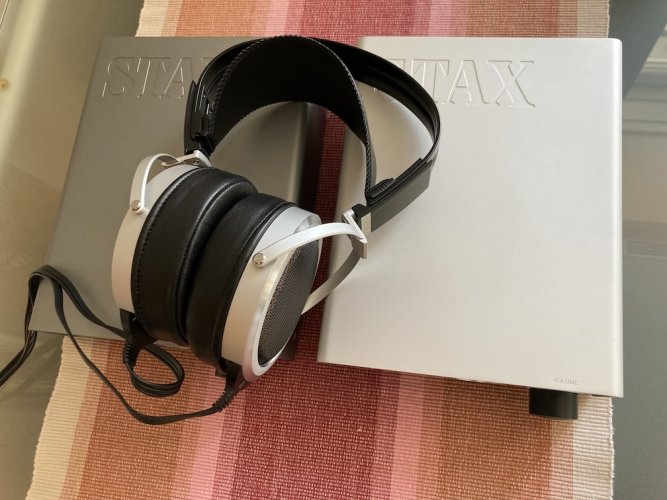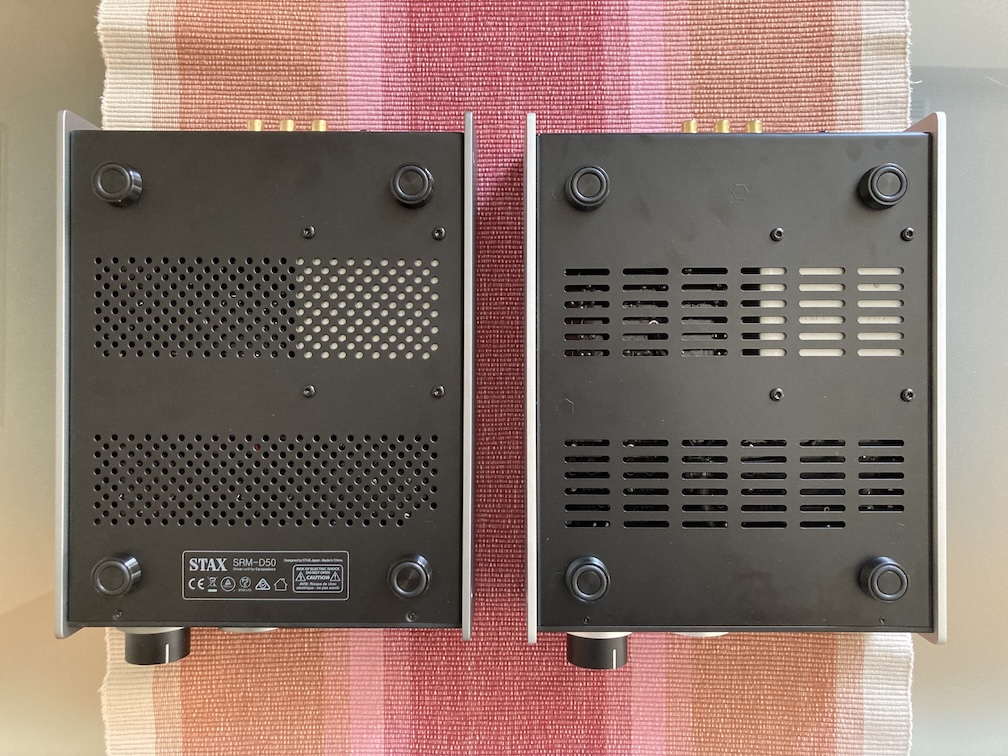So I finally found a second-hand silver 230V SRM-D50 from 2022. It came in its original box with all the original manuals and accessories. Before listing my 2024 ‘dark silver’ unit for sale, I thought I should do a thorough comparison of the two side by side.
Visually, all the parts that are silver on the early version are dark grey (‘dark silver’ according to Stax) on the current one, which means not only the ‘hood’ but also the input switch as well as the frames around the VU-meter and volume knob on the front. The vents on the bottom are a different shape, and as already noted the current version has vents on the back as well. Finally the optical input on the older version is ‘bare’, while on the current one it has a cover flip. Other than that, the only differences I can spot are with what is printed (or not) on the back and bottom of the units. (The LEDs that highlight the selected input and light up the VU-meter are the same orange color on both units.)
Both versions come in the exact same packaging and with the same accessories. The microfiber cloth and RCA cables are identical, while the power and USB cables look slightly different but are of similar quality and finish.
After about an hour of listening, going back and forth between the two units, both units were running hot. The temperature of the ‘hood’ was about the same on both units. The bottom of the chassis was hotter on the older unit, while the back of it was hotter on the newer one (in fact on the older unit it did not heat up much at all). Overall the heat of the chassis was slightly better distributed on the newer unit than on the older one, but it was still hotter on the bottom than on the back and overall the newer unit did not feel significantly less hot. The front of the units did not heat up much.
Sonically the two units are very close, as one might expect since Stax chose not to advertise the second iteration of the SRM-D50 as a revision. One thing that surprised me is that the volume knob is calibrated slightly differently. When I was at 1 o'clock on the older unit, I had to be close to 2 o'clock on the newer one to achieve a similar gain using the exact same source (cable included) and headphones. Once I was able to match the gain on the two units, my impression was that the newer one had a tad less treble than the older one. That difference was exactly the same whether I was using the embedded DAC or an external DAC through the line input, which suggests that the embedded DAC sounds the same on both units and that the difference is down to the energizer part only.
With the embedded DAC, which is rather dull sounding compared to any external DAC I have tried, the older unit sounded a bit better to me. When using external DACs my preference between the two units would change depending on the DAC and the music I was listening to. It was a very small difference anyway.
One thing that is identical on both units and which seems odd to me is that while the volume is roughly the same with various external DACs (as it should be), when switching to the embedded DAC there is a drop of several dBs. It seems that the ‘output’ of the embedded DAC is not calibrated to standard line level (to be clear, there is no analog output on the D50, and I am merely talking here about the signal that is passed from the embedded DAC directly to the energizer internally). Because of this the VU-meter works much better when using the embedded DAC. With external DACs, even with music that is fairly dynamic, the needle tends to be in the red most of the time.
That being said, the D50 really benefits from being paired with a good external DAC. The DacMagic Plus from Cambridge Audio was a significant improvement over the embedded DAC, and the Gustard R26 went several steps further. So in spite of its price the D50 is really able to ‘scale’ quite a bit as the quality of the source improves.
In the pictures the ‘dark silver’ unit is always on the left. I have included a silver MacBook Air in one picture and my SR-009s in another for reference. I don't have a ‘space grey’ MacBook but would expect the ‘dark silver’ D50 to be pretty close to that in color.
































